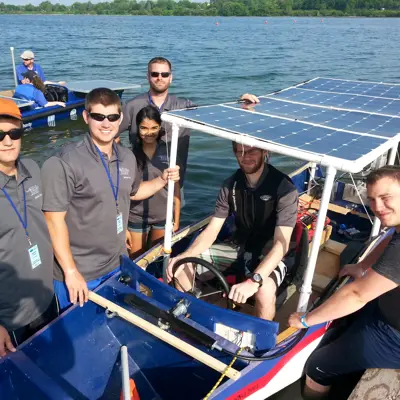
USI team makes a splash in first solar boat regatta
June 18, 2015
Starting with a donated hull, a $2,500 Endeavor! grant and $4,000 in Engineering Department funds, the University of Southern Indiana's first Solar Splash team placed ninth out of 17 teams and took awards for Outstanding Solar Design and Rookie Team.
Solar Splash is an international collegiate solar/electric boat regatta sponsored by the Institute of Electrical and Electronics Engineers-Power Electronics Society (IEEE-PELS). It was held June 10-14 in Dayton, Ohio, and included competitive events focused on speed, maneuverability and endurance. In addition to the water events, each team submitted a technical design report and gave a poster presentation.
"The Solar Splash competition presents an authentic engineering design experience," said Dr. Paul Kuban, professor of engineering and faculty advisor for USI's Solar Splash Team. "The students are required to work within a team to develop and implement an alternative energy solution with multi-disciplinary concerns. This improves the students' electrical and mechanical problem solving proficiency, and also strengthens their communication and teamwork skills."
Team captain Chad Wargel '15 (engineering) had no experience designing or building anything solar-powered, and that's what drew him to the competition. "It was my intention to choose a topic that was unfamiliar to me," he said. "Choosing a topic that doesn't require research or an original thought may end with a favorable grade, but what a waste of an opportunity to learn something new and become a better engineer."
To gain competitive insights, the team, which also included senior engineering majors Rachel Athippozhy and Jackson Traylor and 2015 engineering graduates Nolan Ballard, Jacob Kaiser and Preston Richard, studied the technical design reports of the past five winners published on Solar Splash's website. They redesigned the boat's cockpit, moving it forward so the boat would be more balanced, sourced solar and engine parts and materials, built the outboard propulsion unit, and put in lots of hours outside of their busy course loads to design a competitive craft. They did it in the span of one semester, whereas most competing teams work on their boats for a year.
"We did it in half the time with half the money," Wargel said.